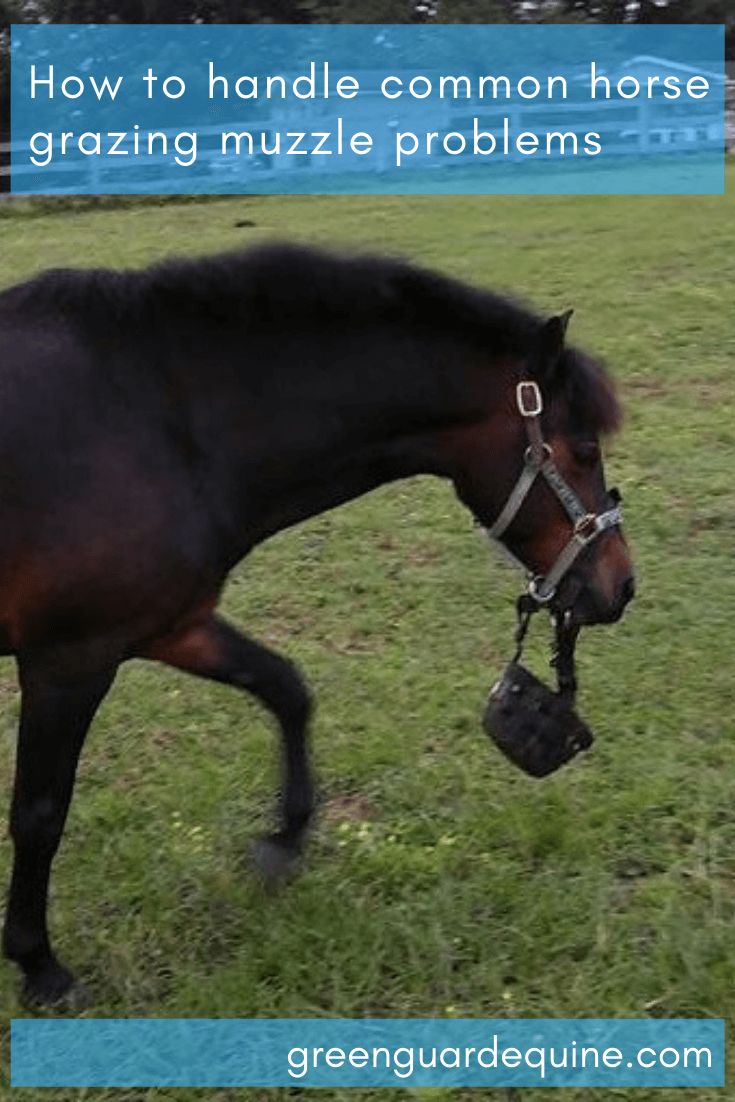Imagine it’s the dead of summer. It’s 95 degrees outside and your horse has got a heavy canvas muzzle on his face. This is when horses need a muzzle the most, but the muzzle he’s been wearing is rubbing and the sores are infected due to the heat and bacteria. He’s having trouble breathing and facing dehydration. We can’t put our horses through that and expect them to work and show as well.
So what keeps you from putting a muzzle on your horse? Is it that you are tired of spending money and wrestling your horse to get him to accept the new facial accessory that he dumps in the field or deposits on a distant fence after 5 minutes?
Based on these experiences, many horse owners have become suspicious and wary, or even terrified to use anything else because they are expecting the same results. I am here to tell you that you are not alone - many of us have been there too - and there is still hope for your horse yet! In this article, I’m going to share some insight into the most common muzzle problems and what might be causing them.
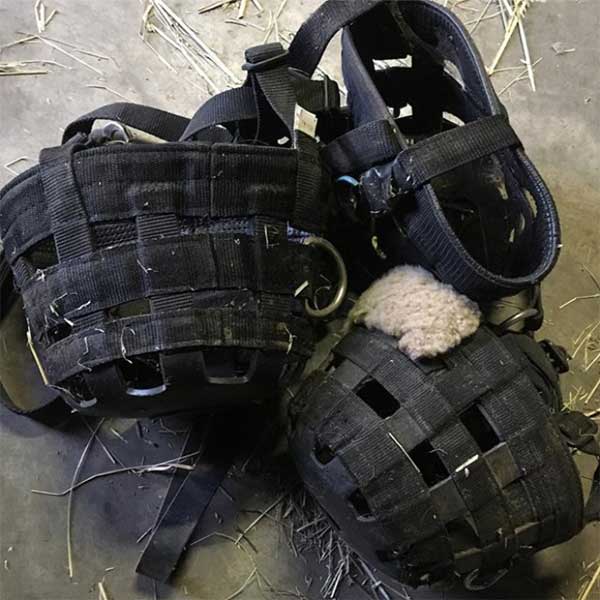
Raise your hand if you've got a "grazing muzzle graveyard" in your barn! Photo by Alanna on Instagram.
Rubbing and chafing
This is the most common concern I hear from people worried about purchasing a new muzzle. The traditional canvas or nylon muzzle has rubbed their horse’s chin raw, often leaving open sores and made the horse miserable. Traditional grazing muzzles are shaped like a round bucket and fit fairly snug so it stays on the horse, at least in theory. The problem is that the canvas is wrapped around and constantly touching the horse’s nose, causing irritation and chafing on the nose and/or chin when the horse is chewing.
Using a tight or restrictive muzzle is one source of rubbing. Another reason for rubbing is things getting trapped inside the muzzle. Most muzzles create a tight enclosure around a horse’s nose and mouth. Moisture, dirt, and debris can easily find their way inside. The longer they remain, the more likely these are to cause friction and irritation. This can lead to cuts and lacerations on the horses nose and chin, as well as opportunities for infection, making for quite a disgruntled horse.
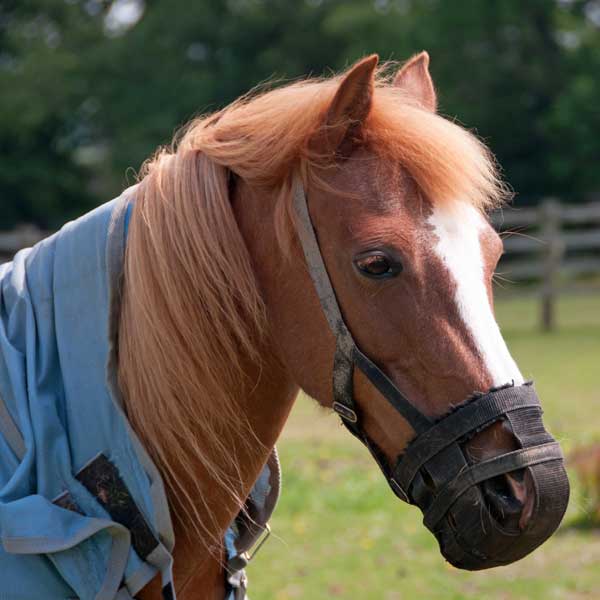
Traditional grazing muzzles fit too tightly around the horse's nose and mouth. Photo by Chelle129 on Shutterstock.
Leading a horse to water
Dirt, grit, and debris are not the only things that tend to remain inside many grazing muzzles. Moisture caused by rain or sweat is not able to dry or evaporate naturally inside nylon, canvas, or similar cloth materials that make up most traditional grazing muzzles. Heat and moisture create the ideal conditions for bacteria and mold to grow, thrive, and reproduce.
Add poor ventilation, and suddenly, you’ve got a horse that is forced to deal with a muzzle that may be injuring them while they’re trying to graze, and encouraging secondary infections at the same time. Even the act of simply drinking water can offer its own its own issues, since the design of many grazing muzzles leads not only to poor ventilation, but also poor drainage.
The design of most traditional muzzles have a hole right in the center, close to the horse’s mouth. When horses drink water while wearing these muzzles, the hole in the bottom drains very slowly and can make the horse feels as though they are drowning. Because of this, you horses may stop trying to drink with the muzzle on and become dehydrated.
Air flow, breathing, and heat
Muzzle ventilation is a common concern among those with easy-keepers especially in the hotter months. When looking at the design of most grazing muzzles, you will notice they wrap very near to the nostrils. This alone can cause the horses to have a lot of breathing issues. The lack of oxygen is a major concern especially in horses with heaves -- the scientific term is Recurrent Airway Obstruction -- or other chronic conditions or allergies that make breathing difficult.
Durability
There are two things I hear regularly about people’s experience with traditional grazing muzzles. First, it’s “my horse goes through 3 or 4 nylon muzzles in a single season.” Second is “my horse ate the hole bigger and bigger until the entire bottom fell out.” The idea behind the design of the center-hole grazing muzzle was to limit grass intake by limiting access to a single point.

Scotchy the horse chewed a gigantic hole in this grazing muzzle, making it practically useless. Photo by Mariah on Twitter.
When a small hole meets a horse-sized appetite, it leads to rapid wear. Horses repeatedly peck away at the same spot on the muzzle. This quickly increases the size of the hole, which defeats the purpose of the muzzle altogether. The forced pressure on the rubber bottom of the muzzle can also push it away from the nylon and detach it, another way that horses destroy so many grazing muzzles.
Houdini horses escaping the muzzle
Some horses feel trapped and confined because traditional muzzles are not well ventilated. Horses are naturally very playful, as well as intelligent. They are brilliant at teaching other horses how to assist in their escaping adventures. Helpful herdmates will sometimes play with their friends’ halters or muzzles and help take them off.
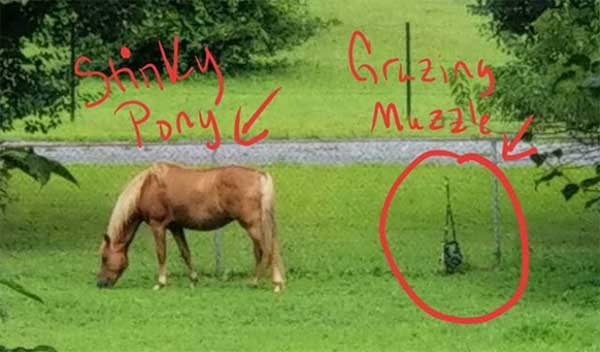
Reba the Morgan was at least kind enough not to leave her grazing muzzle out in the pasture! Photo by Jessie on Instagram.
Horses will do anything to feel comfortable, breathe easily, and get back to munching on grass. Is your horse a Houdini? If your answer is yes, you are far from being alone. I know of horses who will put their head under a fence board and pull it off from behind their ears.
Others will pull it down over their nose and you will find it in their mouth or around their neck. Rolling on the ground is also very common. This allows them to rub their head on the ground and force the contraption over their ears.
GreenGuard is not your typical grazing muzzle!
The makers of GreenGuard muzzles noticed all these common behaviors. They designed a grazing muzzle for horses, ponies, and donkeys that takes all of these factors into consideration.
How does the GreenGuard muzzle improve upon standard or traditional basket muzzles?
- Rubbing: Due to the square shape of the GreenGuard muzzle, we don’t see the rubbing that is so prevalent with traditional nylon muzzles. The muzzle doesn’t lay on their face where it can attract moisture and debris. This limits or eliminates friction when the muzzle moves around their nose. It is very open around the sides, allowing the horses to feel the grass within reach. This tricks them into thinking they are getting more grass than they actually are.
- Debris and drainage: The open basket design means that horses are able to eat and drink without having to worry about trapped water or increased heat. The holes are large enough to allow water and debris to move through the muzzle basket.
- Airflow: The muzzle basket is spacious enough to keep plenty of air flowing through. This does not mean that they are eating more. Since the center, where the horse would eat the most grass, is actually blocked, they have to move around the bottom and work around it. Eating out of only one or two slots at a time means that, depending on the horse and the pasture conditions, a GreenGuard muzzle reduces grass intake from 30%-70%, which is equal to or better than other muzzles on the market.
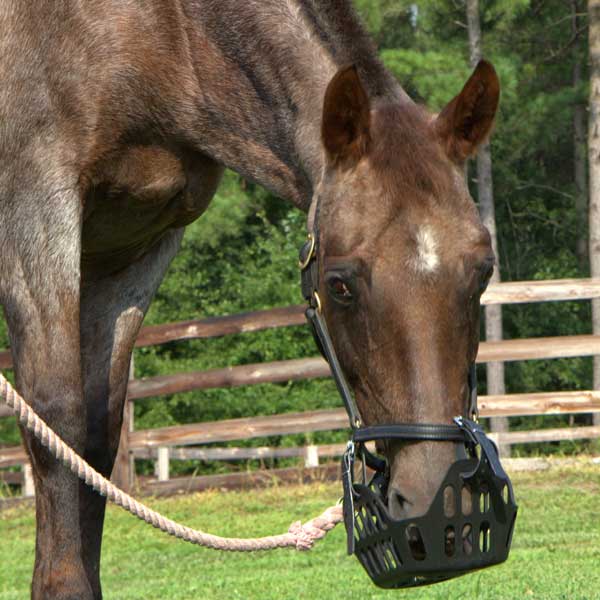
GreenGuard muzzles are designed to address all of the most common issues!
- Durability: This is where the GreenGuard really shines. Our grazing muzzles are made from a poly-resin material that is not only sturdier, but also lightweight. Many of our users have gone from needing a new muzzle every season, to being on their third, fourth, or even fifth consecutive seasons with a GreenGuard. GreenGuard is the only muzzle company that offers a one-year, one-time replacement warranty for our muzzles in case of breakage or wear. These muzzles are made in Germany and have been tried, tested, and trusted in Europe for over 20 years.
- Anti-Houdini: The muzzle and halter are highly adjustable, ensuring that you get a good, comfortable fit for your horse. We are also masters at troubleshooting. If you’re having any problems, get in touch with us! For the strongest or cleverest Houdinis, we suggest a neck strap that attaches through the top of the halter crown piece and buckles behind the throat latch.
Grazing muzzles: they look weird, but they’re necessary!
There are still so many horse owners who resist investing in any kind of grazing muzzle even as their horses pack on the pounds. Time and again people will ask if muzzles are cruel or mean. I always think -- and sometimes say -- that it’s much less cruel to take care of your animal and provide the right tool to help them than to allow them to develop metabolic disorders and other medical problems.
Not all muzzles are created equal! As a horse owner, you have have to decide what is the best one for you and your horse. A GreenGuard may have a higher price tag than a traditional muzzle, but most customers will find that the comfort, quality, and durability make the investment in your horse’s health well worth it. Ask your friends and peers who’ve tried the GreenGuard and choose for yourself!
